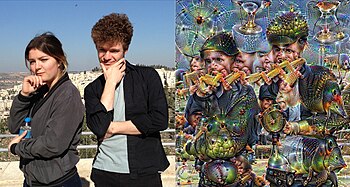Psychedelic
Psychedelic (composed of ancient Greek ψυχή psychḗ 'soul' and δῆλος dẽlos 'obviously, obviously') denotes a changed state of consciousness that can be achieved through the consumption of psychedelics (psychedelic psychotropic substances ) . This is characterized, among other things, by the partial or complete abolition of the boundaries between self and outside world as well as the temporary transcending of everyday consciousness and everyday experience. The term emerged in 1956 from a correspondence between the psychiatrist Humphry Osmond and the writer Aldous Huxley .
Psychedelic art
The not precisely defined style of psychedelic art tries to represent or manifest the impressions experienced in the psychedelic state, or to deepen the trip under the influence of psychedelic substances or at least to offer an intensifying stimulus.
A number of styles of music make reference to the psychedelic state of consciousness. These include Psychedelic Rock (Acid Rock), Psychedelic Folk , Psychedelic Trance (Psytrance / Goa) and Stoner Rock . Following Lyserg acid diethylamide (LSD) ( acid = engl. Acid ) further be such as psychedelic perceived music. B. Acid House , Acid Rap, Acid Techno , Acid Trance and Acid Jazz .
Important representatives of psychedelically influenced music include: a .:
- Psychedelic Rock: Grateful Dead , Pink Floyd , The Beatles , The Doors
- Psychedelic Trance : 1200 Micrograms , Infected Mushroom
- Psychedelic Ambient (Psybient): Shpongle
See also
- Change of consciousness (expansion of consciousness)
- spirituality
Web links
- Erowid Visionary Arts Vault - Collection of visionary art on Erowid
Individual evidence
- ↑ Huxley, A., Palmer, C., and Horowitz, M. (1977): Moksha: Writings on Psychedelics and the Visionary Experience (1931-1963). New York, NY: Stonehill. To Dr. Humphry Osmond [smith 744], 107.
